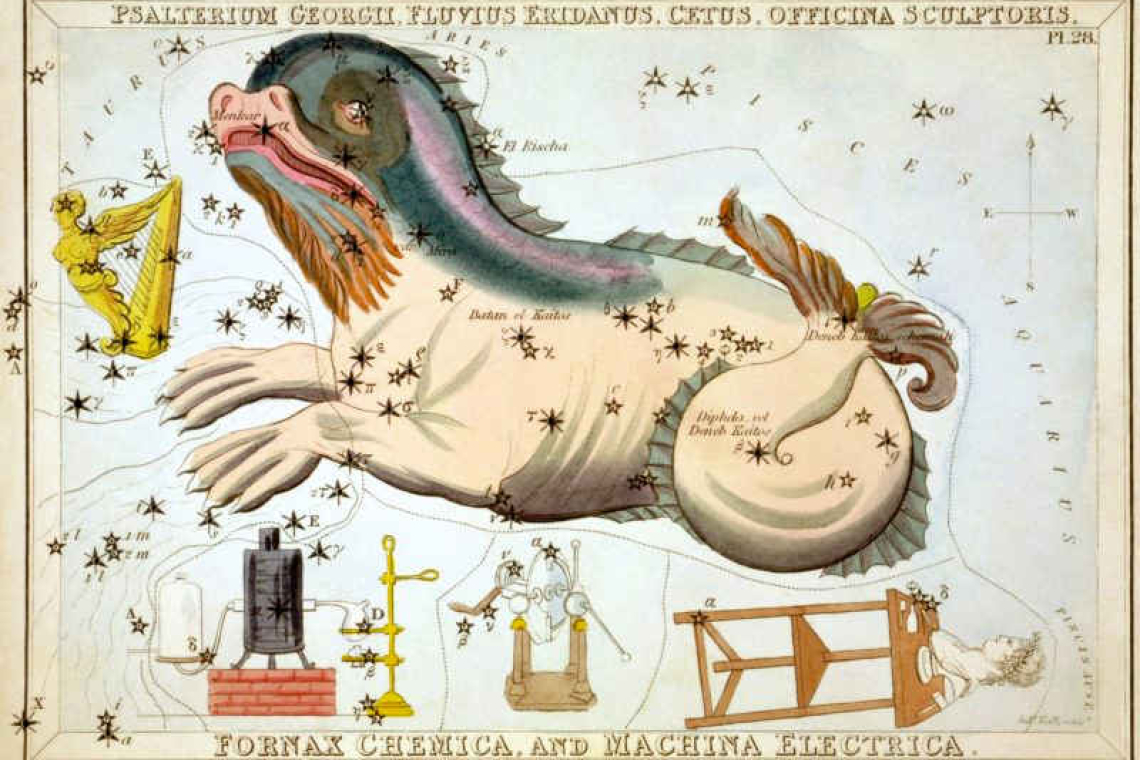~ St. Maarten’s Backyard Astronomy for December 15-17 ~
Sun rises at 6:36am
Sun sets at 4:39pm
Lunar phase: 1st quarter, waxing crescent
Moon rises at 10:06am
Moon sets at 9:35pm
This weekend, let’s find a whale in the sky! The constellation Cetus is large, as certainly befits a whale! In fact, Cetus is one of the largest of all the classic constellations, but it’s often sadly overlooked due to its more eye-catching neighbours. This weekend, let’s use those bright neighbours to find Cetus, who admittedly is no Moby Dick, but will do nicely as our own white whale about which to obsess.
In Greek mythology, Cetus was a fearsome sea monster who nearly gobbled up the fair Princess Andromeda, daughter of the celestial royals Cassiopeia and Cepheus. Luckily, the hero Perseus arrives just in time to save the day, and slays Cetus. From here you get to choose your ending: either Cetus dies on the sword of Perseus or he dies by turning to stone after viewing the severed head of Medusa, which Perseus just happened to have hanging around.
Back to our stars: Cetus the Whale sits just outside the Winter Circle, the giant ring that includes seven first-order stars from six different constellations, most notably Orion and Taurus. We have devoted plenty of space in our Night Sky articles to the Winter Circle over the weeks, months and, yes, even years, so I will take for granted that you might know how to find Orion and Taurus and the other members of the circle. Taurus, you recall, has a V-shaped head marking the horns of the Bull. That V-shape points towards Cetus. In the evening hours this weekend, Cetus will be leading the Winter Circle across the sky from east to west, taking the zenith spot, directly overhead, around 9:00pm.
Located near Cetus and Taurus this weekend, you can hardly miss Jupiter. Just look in the evening hours for the bright star dominating the southern sky up very high on the celestial dome. Use your binoculars to zoom in and see the solar system’s biggest planet and its string of tiny moons. By the way, our moon will pass just above Cetus next week, starting near the tail on December 19, crossing above the body and ending near the whale’s head by December 21. This gives you a great opportunity to locate and learn some of its stars.
The bright star in the head of Cetus is Menkar, also called Alpha Ceti. It’s located about 250 light-years away. The star that marks where the whale’s head joins its neck is Kaffaljidhma, or Gamma Ceti. Moving toward the body of the whale is Delta Ceti, a star that is useful later for finding a galaxy. The next star in the body of the whale is the famous Mira, or Omicron Ceti. Mira is a variable star, meaning that it changes in brightness. This long-period variable star can get as bright as magnitude 2 and as dim as magnitude 10. Another curious feature of Mira is that it is rushing through space and ejecting material as it goes, producing a tail that stretches for an incredible 13 light-years. The brightest star in Cetus lies in the tail of the beast and goes by three different names: Beta Ceti, Diphda or Deneb Kaitos. Finally, the star Earendel in Cetus is the most distant star ever detected. It is so distant that the light we now see began shining almost 13 billion years ago.
There are also galaxies in Cetus. Messier galaxy M77 lies just a degree east-southeast of the star Delta Ceti and is 47 million light-years away. The face-on spiral galaxy has an active galactic nucleus and a noticeably bright centre. Those with large telescopes may be able to catch another galaxy between Delta Ceti and M77. The galaxy NGC 1055 is a tiny blue swirl, lost in the cosmic sea.
Thank you for keeping up with the Night Sky articles, backyard astronomy designed for St. Maarten sky viewing. FYI: If you are out later on in the week, note that each star rises about four minutes earlier each day than written here, and the moon rises 50 minutes later. Night Sky is researched and compiled by Lisa Davis-Burnett. Earthsky.org is a key resource for information and images. Questions or comments? Email This email address is being protected from spambots. You need JavaScript enabled to view it.







